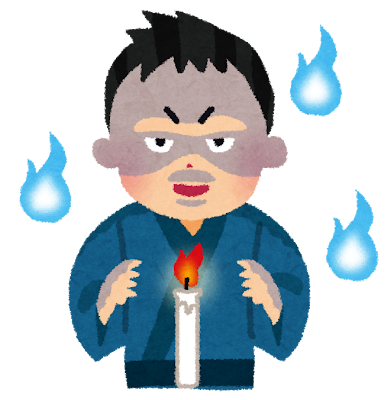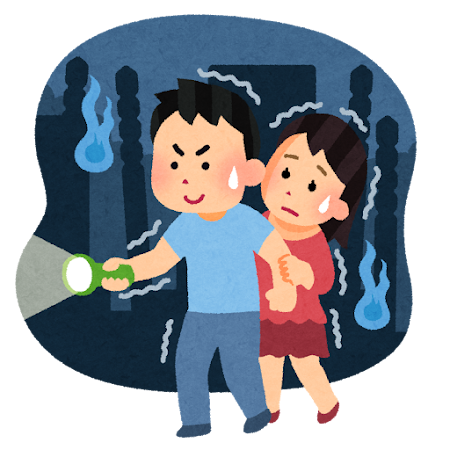As scorching summer engulfs Japan, how are you keeping cool? Are you comfortably lounging in an air-conditioned room or finding solace with just a fan? Long before electric fans and air conditioning became common, people in Japan had another way to beat the heat. They would gather on summer nights to share ghost stories or participate in courage tests. Amidst eerie tales and settings, they would seek a shiver-inducing chill to counter the heat. Ghost stories and courage tests, along with wind chimes, yukatas, festivals, and fireworks, have become part of Japan’s summer traditions.
Fair warning! This article will include famous Japanese ghost stories. If you’re not too fond of supernatural tales, be mentally prepared before diving in!
Featured image:https://www.irasutoya.com/2013/08/blog-post_9820.html
Kaidan: Let’s Share 100 Ghost Stories Together

Japan Pocket Wifi Rental
UNLIMTED DATA SIM CARD
Japan Travel Prepaid SIM card
Japanese “怪談” (kaidan) refers to stories that evoke fear or eeriness, commonly known as ghost stories or tales of the supernatural. This naturally includes stories involving creatures like monsters and spirits. Among them, “四谷怪談” (Yotsuya Kaidan), “皿屋敷” (Sara Yashiki), and “牡丹灯籠” (Botan Dōrō) are known as the three major ghost stories of Japan. In modern times, literati in Japan began to hold gatherings known as “百物語” (Hyakumonogatari), where they shared ghost stories. This practice involves telling one story per person, extinguishing a candle or lantern after each story. It is said that when 100 stories are told and 100 candles are extinguished, real monsters will appear. It has become one of Japan’s famous summer traditions.
百物語 (Hyakumonogatari)
The term “百物語” refers to the practice of people gathering to share ghost stories, extinguishing a candle or lantern after each story. It is said that when 100 stories are told and 100 candles are extinguished, real monsters will appear.

Japanese lantern
The traditional way of holding the Hundred Stories Gathering is as follows:
- Gather a group of people on a night of the new moon, usually at someone’s house. Ideally, the location should have three rooms arranged in an L-shape, but if not, even two rooms will do.
- Everyone gathers in one of the edge rooms, and this room is darkened. The adjacent middle room is also darkened. In the farthest room, set up 100 lanterns (later evolved into 100 candles), with blue paper lantern shades. A table is placed in the room, with a mirror on top of it.
- Participants enter wearing blue clothes and are not allowed to bring weapons or other dangerous items (legend has it that weapons like knives might have exorcising effects).
- Participants take turns telling ghost stories. After each story, the storyteller goes in the dark to the innermost room, where they remove the wick from one lantern (later changed to blowing out one candle), then they use the mirror to reflect their own face. After that, they return to the starting room. During this process, others can continue with the storytelling cycle.

It is said that when 100 ghost stories are told and 100 lanterns are extinguished, and all three rooms are plunged into darkness, the true monster/ghost will appear. Therefore, during many Hyakumonogatari, only 99 ghost stories are told, and 99 lanterns are extinguished, and then everyone waits together for dawn.
The internationally renowned SCP Foundation also has containment of works based on the concept of the Hyakumonogatari (SCP-5999).
“四谷怪談” (Yotsuya Kaidan), “皿屋敷” (Sara Yashiki), and “牡丹灯籠” (Botan Dōrō)
“四谷怪談” (Yotsuya Kaidan)

Picture: Wikipedia:四谷怪談
The Yotsuya Kaidan is said to be a ghost story adapted from a true event during Japan’s Genroku era. Originally named “Tōkaidō Yotsuya Kaidan,” it’s arguably one of the most famous ghost stories in Japan’s history and has been adapted into various forms of performance art, including Kabuki theater.
There are several versions of the Yotsuya Kaidan, each with slight variations in details, but the basic content is as follows: A ronin named Iemon has a wife named Oiwa. Due to his greed for power, Iemon secretly marries into the Tamiya family without Oiwa’s knowledge. When Oiwa discovers this deception, she commits suicide (some versions suggest she was murdered by Iemon or simply disappeared). After her death, Oiwa becomes a vengeful spirit, causing Iemon and the members of the Tamiya family to die one after another.
“皿屋敷” (Sara Yashiki)

Picture: Wikipedia:皿屋敷
Another well-known Japanese ghost story is “Sara Yashiki,” which can be roughly translated as “The Plate Mansion” in English. This ghost story has many versions, but most of them revolve around the tale of a female ghost named Okiku who is counting plates.
It is said that the Edo period’s “Bancho Sara Yashiki” is the most representative version.
In this version, Okiku was a maid in the Aoyama family, whose head was a samurai responsible for maintaining local peace. During a New Year’s feast, the master instructed Okiku to bring out a set of priceless family plates to serve the guests. However, due to a sudden entry of a stray cat into the kitchen, Okiku was startled and accidentally broke one of the plates. Out of a set of ten plates, only nine remained. The master, in a fit of anger, accused Okiku of secretly hiding the plate to sell for money. He scolded and beat her, even cutting off her middle finger as punishment. Despite Okiku’s explanations, she was expelled from the house and chose to end her life by jumping into a well.
Afterwards, every night from the well of the Aoyama family, the sound of Okiku counting plates could be heard: “One plate, two plates, three plates…” When she reached the ninth plate, she would pause and weep, then start counting from the beginning again.
It is said that when the head of the Aoyama family looked into the well, he would see a pale-faced Okiku with blood in her mouth. She would be seen counting plates and saying softly, “Master~ there’s still one plate missing~.”
“牡丹灯籠” (Botan Dōrō)

Picture: Wikipedia:牡丹灯籠
The ghost story of the “Botan Dōrō/Peony Lantern” is said to be inspired by a tale called “The Peony Lantern Story” from the Chinese Ming Dynasty’s collection of strange stories, “Jiandeng Xinhua.”
The Japanese version of the Peony Lantern roughly goes like this: In the past, there was a ronin named Shinzaburou Hagiwara who met a girl named Otsuyu. Otsuyu claimed to be the daughter of a hatamoto samurai named Iijima Heizaemon. The two fell in love at first sight, and every night Otsuyu would visit Shinzaburou’s house carrying a peony lantern, where they would meet in secret. However, Shinzaburou eventually discovers that Otsuyu is actually a spirit. He receives a sealed talisman from a wandering monk, who tells him to paste it on his door and stay inside his house on specific nights, avoiding any interaction with Otsuyu. Although Otsuyu continues to linger around his house each night, she’s unable to enter his home due to the talisman’s protection. She calls out Shinzaburou’s name with sadness and resentment every night. Until the last night, when Otsuyu tricks Shinzaburou by telling him it’s already morning, leading him to tear off the talisman and leave the house.
In Japanese ghost stories, many protagonists are vengeful spirits unable to find peace due to injustices or resentments. “Peony Lantern,” on the other hand, is filled with a Chinese-style sentiment, focusing more on depicting a romantic connection between the living and the dead. By comparing the story with the original Chinese tale, “The Peony Lantern Story,” one might find even more intriguing facets.
Courage Test: Exploring Haunted Houses

Perhaps you might encounter scenes like this in Japan’s ACG (Anime, Manga, Games) culture: the protagonist and friends venture into a supposedly haunted abandoned school building on a summer night, armed only with flashlights.
This is also a common way for Japanese people to beat the heat during summer: Courage Tests (Japanese: 肝試し/Kimodameshi).
Legend has it that Courage Tests originated in the late Heian period. Emperor Hanayama at the time, during a summer’s early morning at 3 am, sent three sons of Fujiwara Kaneie to a house rumored to be haunted. Eventually, only Fujiwara no Michinaga entered and brought back a wooden fragment from a pillar as evidence. This story is generally believed to be the earliest Courage Test.
Modern-day Courage Tests usually take place in locations like graveyards, forests, ruins, places that are relatively safe yet give a shiver down one’s spine. Generally held when the sky is fully darkened, organizers often arrange dedicated scary characters, such as people dressed as ghosts or pre-arranged scenes and props.
Before the Courage Test starts, sometimes ghost stories related to the location are told to heighten the atmosphere of fear. Participants go alone or in groups of 2 to 4 people, following a predetermined route into the venue. Along the way, there might be ghosts covered in white cloth, sudden appearances of monsters, skeletons, eerie music playing, or screams, and even konjac jelly hanging on bamboo sticks brushing gently over participants’ heads or shoulders – all aimed at scaring them.
If participants withstand this series of scares and reach the finish line, they generally receive small props (like cards or snacks) as proof of completing the course.
Japan Pocket Wifi Rental
UNLIMTED DATA SIM CARD
Japan Travel Prepaid SIM card
